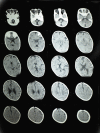Holoprosencephaly in an Egyptian baby with ectrodactyly-ectodermal dysplasia-cleft syndrome: a case report
- PMID: 22272605
- PMCID: PMC3281777
- DOI: 10.1186/1752-1947-6-35
Holoprosencephaly in an Egyptian baby with ectrodactyly-ectodermal dysplasia-cleft syndrome: a case report
Abstract
Introduction: Ectrodactyly-ectodermal dysplasia-cleft lip or palate syndrome (OMIM No. 129900) is characterized by the triad of ectrodactyly, ectodermal dysplasia and facial clefting (of the lip and/or palate). Holoprosencephaly denotes a failure in the division of the embryonic forebrain (prosencephalon) into distinct lateral cerebral hemisphere. The association between ectrodactyly-ectodermal dysplasia-cleft lip or palate syndrome and holoprosencephaly is very rare. Here we report holoprosencephaly in an Egyptian infant with ectrodactyly-ectodermal dysplasia-cleft lip or palate syndrome.
Case presentation: An 11-month-old Egyptian female baby was referred to our institution for an evaluation of poor growth; the pregnancy and perinatal history were uneventful. On examination, her growth parameters were below the third centile, she had bilateral ectrodactyly of both hands and feet, dry rough skin, sparse hair of the scalp and operated right cleft lip and cleft palate. Computerized tomography of her brain revealed holoprosencephaly.
Conclusion: The importance of the early diagnosis of this syndrome should be emphasized in order to implement a multidisciplinary approach for proper management of such cases.
Figures
Similar articles
-
Ectrodactyly-ectodermal dysplasia-cleft lip and palate syndrome.J Indian Soc Pedod Prev Dent. 2014 Oct-Dec;32(4):346-9. doi: 10.4103/0970-4388.140972. J Indian Soc Pedod Prev Dent. 2014. PMID: 25231046
-
Ectrodactyly, ectodermal dysplasia, and cleft lip/palate syndrome: A case report of "Incomplete syndrome".Contemp Clin Dent. 2012 Apr;3(Suppl 1):S115-7. doi: 10.4103/0976-237X.95120. Contemp Clin Dent. 2012. PMID: 22629050 Free PMC article.
-
SIBLINGS AFFECTED BY ECTRODACTYLY-ECTODERMAL DYSPLASIA AND CLEFT LIP/PALATE (EEC) SYNDROME PRESENTING NORMAL PARENTS: GERMLINE MOSAICISM?Rev Paul Pediatr. 2017 Apr-Jun;35(2):234-238. doi: 10.1590/1984-0462/;2017;35;2;00017. Epub 2017 May 15. Rev Paul Pediatr. 2017. PMID: 28977327 Free PMC article.
-
Ectodermal dysplasias associated with clefting: significance of scalp dermatitis.J Am Acad Dermatol. 1992 Aug;27(2 Pt 1):249-56. doi: 10.1016/0190-9622(92)70179-j. J Am Acad Dermatol. 1992. PMID: 1341424 Review.
-
Corneal changes in ectrodactyly-ectodermal dysplasia-cleft lip and palate syndrome: case series and literature review.Int Ophthalmol. 2012 Oct;32(5):475-80. doi: 10.1007/s10792-012-9585-6. Epub 2012 May 23. Int Ophthalmol. 2012. PMID: 22618129 Review.
Cited by
-
FGFR1 mutations cause Hartsfield syndrome, the unique association of holoprosencephaly and ectrodactyly.J Med Genet. 2013 Sep;50(9):585-92. doi: 10.1136/jmedgenet-2013-101603. Epub 2013 Jun 28. J Med Genet. 2013. PMID: 23812909 Free PMC article.
References
-
- Rudiger RA, Haase W, Passarge E. Association of ectrodactyly, ectodermal dysplasia, and cleft lip-palate. Am J Dis Child. 1970;120:160–163. - PubMed
-
- Cockayne EA. Cleft palate-lip, hare lip, dacryocystitis and cleft hand and foot. Biometrika. 1936;28:60–63.
-
- Koley S, Choudhary SV, Salodkar A, Saoji V. Ectrodactyly, ectodermal dysplasia with cleft lip and palate: a case report. JPAD. 2009;19:240–242.
LinkOut - more resources
Full Text Sources




